
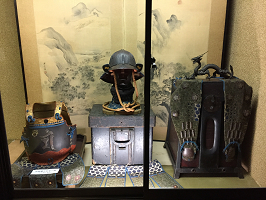

おもしろ体験博物館
江戸民具街道でじたる案内人
展示品紹介
Japanese Folk Art Museum
Edo Mingu Kaido Digital Guide
What you can see!
Home >展示品紹介(Exhibits)



おもしろ体験博物館”江戸民具街道”には秋澤達雄館長が数十年かけて収集した様々な民具が展示されています。その多くはありきたりの道具類で古くなり捨てられる運命にあったもので、また縁があって譲り受けたものが沢山あります。展示品は江戸時代、明治時代、大正時代、昭和初期に一般庶民が使った生活の道具です。その一つ一つに使う者のことを考えた創意工夫や決して手を抜くことのない職人気質をうかがうことができます。農家で使われたクワや手作りのミノでさえも芸術品と呼んでもおかしくないだけの輝きを放っています。特にあかりの道具は日本人の創意工夫が詰まったすぐれた道具だといえるでしょう。ハイテクの進んだ現代において、我々が見直すべきもの、そして学ぶべきものをこの古い道具類から見出すことができるものと思います。江戸民具街道にて忘れさられた古き良き日本を垣間見て頂ければと思います。
Introduction: Japanese Folk Art Museum "Edo Mingu Kaido" showcases Japanese antiques which have been collected by the owner Tatsuo Akisawa for the past several decades. During the economic growth in Japan, many old items were abandoned; since he was involved in construction business, he had seen many of them thrown away, which he could not withstand and saved them from wasted. Some were donated. Exhibits include things used in daily life of people in the Edo Period (17th-19th c.), Meiji Period (1868-1912), Taisho Period (1912-1926), and the beginning of the Showa Period (1926-). Each item is well built with full of ingenuity, even a household lighting appliance or a hoe or a handmade straw rain-cape of a peasant can be called a work of art. Especially Japanese Akali lighting appliances represent them all. Living in this present high-tech world, there are things that we can learn from these old items. Please come and feel the old Japan and enjoy it at Edo Mingu Kaido. We are sure this would be an experience of your life time that you would never forget.
**********************
展示品概要 Exhibits Main
Categories
**********************
1. 運ぶ道具
Transportation related
2. 時の道具
Time
keeping device
3. 火の道具
Heating
and lighting appliances using the fire
4. 水の道具
Tools
associated with water
5. 食の道具
Tools
supported food culture
6. 士の道具 Samurai's
kacchu armer
7. 農の道具 Peasants tools
8. 工の道具
Artisans tools
9. 商の道具 Merchants tools
10.生活の道具 Daily life tools
11.通信の道具 Communication equipment
**********************
1.運ぶ道具
Transportation related
江戸時代に馬や牛を使って移動することは厳しく規制されていたため、人力により人や物を運んだり移動したりする道具が発達します。人を運んだ代表的な乗り物に駕籠があります。棹につるして二人で担ぎ、重力バランスを保ちながら物を運ぶ道具です。明治時代になると人力車が主要な乗り物となり駕籠は姿を消してしまいますが、人力車も車夫と乗客が前後にバランスを維持しながら移動する乗り物になります。
箪笥の中には移動に関連するものがあります。船箪笥は船の中で使われた小型の四角い携帯用の箪笥です。車箪笥のように車輪が付いていて火事等の災害時に綱を付けて移動することが可能な大型の車箪笥もあります。
During the Edo Period (17th to 19th c.), the use of
horses or oxen was strictly regulated by the government, man-powered vehicles
were developed. Kago (palanquin) is a typical man-powered vehicle to carry
a passenger, which is
carried by two men by keeping a balance.
There are chest of drawers for mobile use called funa-dansu, a small size chest
of drawers used in a ship. Kuruma-dansu is a large size chest of drawers
with small wooden wheels which can be pulled using a rope to transport in case
of emergency like a fire.
|
駕籠 Kago (palanquin)   |
人力車 Jinrikisha   |
船箪笥と車箪笥 Funa-dansu and Kuruma-dansu   |
2.時の道具
Time keeping device
江戸時代の日本では西洋の24時間定時法とは異なる不定時法と呼ばれる時刻制度が採用されていました。これは昼と夜をそれぞれ太陽の角度で六分割するというものです。太陽が真上に南天したところが九つ、そこから30度の角度毎に八つ、七つとなり日没が暮れ六つ、さらに五つ、四つと数えた後、太陽が真裏に位置したところから改めて九つ、八つ、七つと数え、日の出が明け六つとなり、五つ、四つで一巡します。昼間は太陽の角度が時計の文字盤替わりになるので大変便利であったと思われます。年間を通して日照時間の長さが変化するので季節毎に一刻の長さも変わりますが、当時の生活習慣においては十分であったものと思われます。
During the Edo Period, the Japanese utilized the time keeping system called
Futejiho (varying length system) in which hours are defined by seasonally
changing sun 's celestial objects infestation being divided into 6 equal parts
(30 degrees each). During the day time, people could tell time by the
position of the sun and therefore, the system could have been convenient for the
people living in the era without clocks or watches. As the length of day
and night varies throughout the year, so were hours in this time keeping system,
which was totally different from western 24 hours system with each
hour being exactly 60mins.
| 機械式和時計 Mechanical Japanese clock  |
日時計 Sundials  |
香時計 Incense timers  |
 |
 |
|
3. 火の道具
Heating and lighting appliances using the fire
人間にとって火は非常に大切な存在です。電気が登場するまで調理、暖房、あかりには火が使われてきました。今でも内燃機関、火力発電、精鉄、陶芸、ガスコンロ等、火がなければ存在しえないといえるでしょう。江戸時代には庶民文化の発展に伴い、火を使う様々な庶民の道具が発達しました。灯火器、火鉢、煙草盆は一般庶民が使った代表的な火を使う道具になります。
The fire has taken important roles for human. Until the electricity was
widely used, the fire was utilized as the major source for cooking, heating and
lighting. During the Edo Period, a variety of tools associated with the
use of the fire were developed as popular cultures grew. Lighting
appliances, hibachi braziers, and tobacco trays were typical tools used in daily
life of people.
|
あかりの道具 Lighting appliances 

  |
火鉢と鉄瓶 Hibachi braziers and iron Kettles   |
|
囲炉裏と自在鉤 Irori hearth and jizaikagi pot hooks 
  |
煙草盆とキセル Tobacco trays and pipes
 |
4.水の道具
Tools associated with water
江戸の町では上水道が整備され、また各家庭では井戸水を自由に使うことができました。井戸から水をくみ上げるのに井戸桶と滑車が使われました。長屋が密集した江戸の町では火事が起きやすく火消しを行う消防団が組織されていて消防ポンプが装備されていたましたが、これは消火活動を行う火消に水をかけるのに使われました。
During the Edo Period, water supply system was
established and people could use water at their convenience. Buckets and a
pulley were used to draw water from a well. As the City of Edo (current
Tokyo City) was filled with wooden houses, the fire frequently occurred, and
there were organized firefighters groups equipped with water pumps though they
were basically used to splash water onto firefighters.
|
井戸桶と滑車 Water buckets and pulleys 
 |
火消しの道具 Firefighters' equipment 

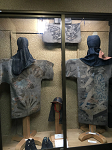  |
5.食の道具
Tools supported food culture
日本人の食文化は江戸期の大衆文化の発展と共に発達したともいえます。器や料理そのものの美しさを大事にするのは日本人の特質でありましょう。日本人の美意識の高さ、物づくりの完成度の高さは江戸期に一般庶民が日常的に使った食文化に関連する道具の中にも見ることができます。
It can be said that Japanese food culture developed in the Edo Period along with
the growth of popular cultures. It is Japanese tradition to appreciate the
beauty of tableware and the appearance of food itself. Japanese aesthetic
sense and perfection in manufacturing can be seen in utensils related to the food culture of common people.
|
お酒の道具 Sake wine containers, servers and sake warmers   |
菓子木型 Confectionary molds   |
6.士の道具
Samurai kacchu armor
庶民の生活道具を主に展示する江戸民具街道には唯一士の道具として甲冑が展示されています。この甲冑は金沢藩中村家から寄贈されたものになります。
Edo Mingu Kaido mainly showcases tools used in daily
life of people though there is a Samurai's kacchu armor exhibited which was
donated by the Nakamura Family of Kanazawa Feudal Domain.
7.農の道具
Peasants' tools
江戸民具街道の前の道を歩くとすぐ田んぼの中に入ることができます。ここ中井町は農村で農家が沢山あります。今ではトラクター等の機械が使われていますが、その昔耕作、収穫、脱穀、精米等はすべて手作業で行われました。
If you walk down the path in front of Edo Mingu Kaido,
you would find yourself in the middle of rice field. Nakai Town is located
in an agricultural region and many farmers are living there. Nowadays,
machines like tractors are used though in the past the works like cultivation,
harvesting, threshing, de-hulling and such were all done by hand.
|
スキ・クワ Plows and hoes   |
足踏水車 Portable man-powered irrigating wheel   |
臼と杵 Mortars and mills 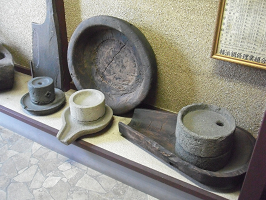  |
|
蓑(ミノ)・バンドリ Rain coats and gear made of straw   |
座繰り・糸巻き車 Zaguri reels and spinning wheels   |
8.工の道具 Artisans' tools
職工(職人)により使い込まれた道具の中には機能美が生み出す独特の美しさを放っているものがあります。人々の暮らしを支えた職人の道具の美しさをお楽しみください。
Some of tools used by artisans for years have artistic
appearance. Please enjoy these tools of artisans who supported daily life
of people.
|
薬研 Grinders 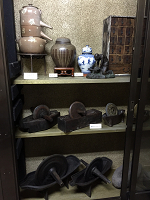  |
墨壺 Sumitsubo ink-pots   |
のこぎり Saws   |
9.商の道具 Merchants' tools
江戸民具街道には計る、計算する、銭を数える、保管する、盗難から守るといった商いに関連する道具が展示されています。
At Edo Mingu Kaido, tools used by merchants to
measure, calculate, count, store and secure are exhibited.
|
秤 Weight scales 
 |
銭箱 Coin boxes 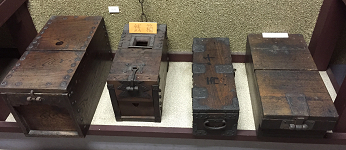  |
|
錠前 Locks 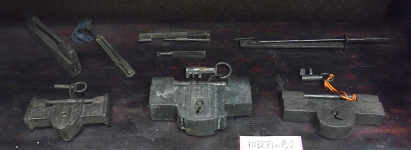  |
そろばん Abacus   |
銭貨 Coins   |
10.生活の道具 Everyday life tools
庶民が日常生活で使った暮らし道具です。
Tools used in daily life are exhibited.
|
アイロン Irons  |
ミシン Sewing Machine   |
|
暮らしの道具 Daily Tools   |
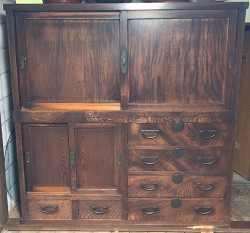  |
11.通信の道具 Communication
equipments
昭和初期の電話機やラジオが展示されています。
Early telephones and radios are exhibited.
|
電話機 Telephones 
 |
ラジオ Radios 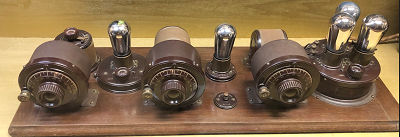  |
おもしろ体験博物館江戸民具街道
神奈川県足柄上群中井町久所418
0465-81-5339
Japanese Folk Art Museum "Edo Mingu Kaido"
Address: 418 Kuzo, Nakai-machi, Ashigara-kamigun, Kanagawa-ken, Japan
Tel: 0465-81-5339